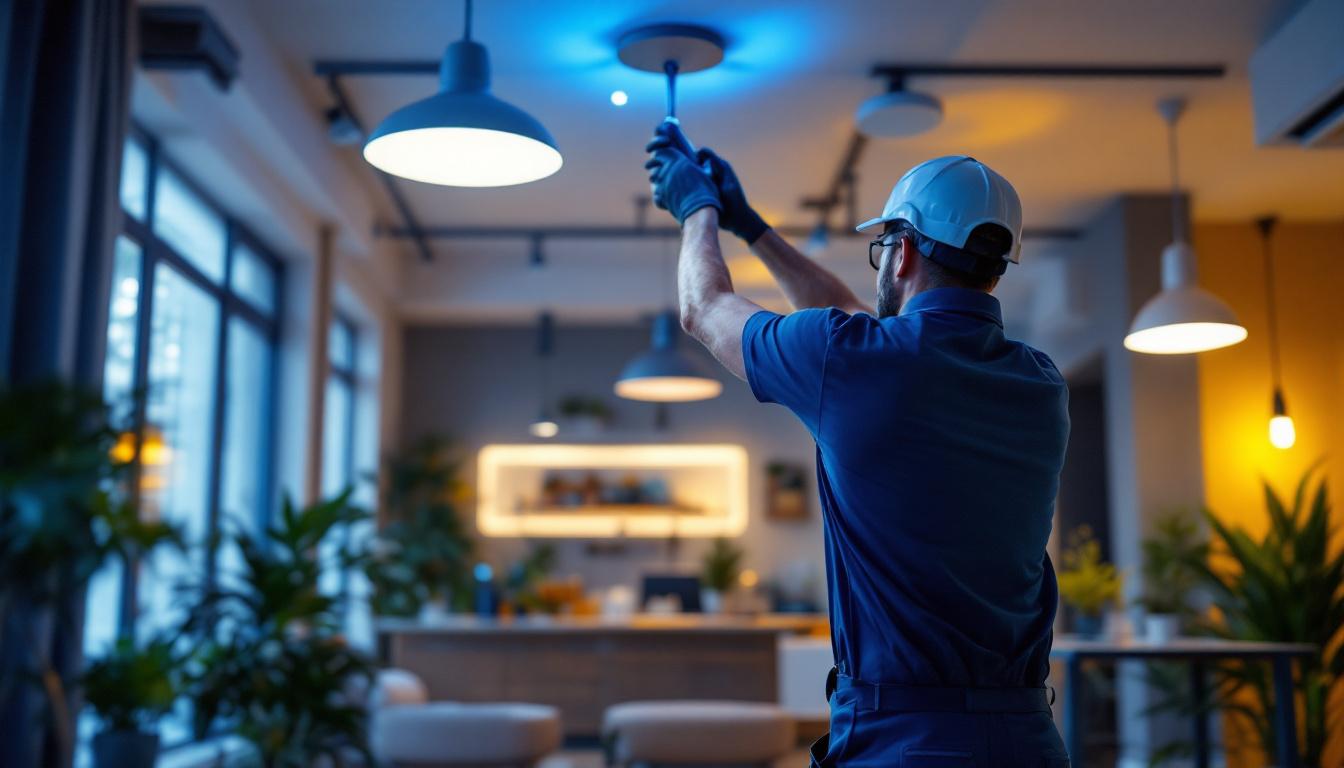
In the world of electrical installations, the button light switch is a fundamental component that plays a crucial role in controlling lighting systems. For lighting contractors, understanding the nuances of button light switches is essential to ensure smooth installations and satisfied clients. This article delves into common issues associated with button light switches and provides practical solutions for lighting contractors to avoid these pitfalls.
Button light switches are designed to control the flow of electricity to lighting fixtures. They come in various styles and configurations, including single-pole, three-way, and dimmer switches. Each type serves a specific purpose and is suited for different applications. Understanding these differences is key to selecting the right switch for a project.
There are several types of button light switches, each with unique features. Single-pole switches are the most common, allowing control of a single light fixture from one location. Three-way switches enable control from two different locations, making them ideal for hallways or large rooms.
Dimmers, on the other hand, provide adjustable lighting levels, enhancing the ambiance of a space. They are particularly popular in dining areas and living rooms where mood lighting is essential. Additionally, there are smart switches that integrate with home automation systems, allowing users to control their lighting remotely via smartphone apps or voice commands. Understanding these types and their applications can help contractors make informed decisions when selecting switches for their projects.
Despite their simplicity, button light switches can present various issues during installation and operation. Common problems include flickering lights, unresponsive switches, and circuit overloads. These issues can lead to client dissatisfaction and may require costly repairs.
Flickering lights, for instance, can often be attributed to loose wiring or a faulty switch, which can be frustrating for homeowners. Unresponsive switches may indicate a need for replacement or could be a sign of a larger electrical issue within the circuit. Circuit overloads, on the other hand, occur when too many devices are connected to a single circuit, potentially leading to tripped breakers or even fire hazards. By being aware of these potential problems, lighting contractors can take proactive measures to avoid them. Proper installation techniques and thorough testing are essential to ensure that button light switches function correctly from the outset. Furthermore, educating clients on the importance of regular maintenance and the signs of electrical issues can empower them to seek help before minor problems escalate into major repairs.
Proper installation is critical to the performance of button light switches. Following best practices can help contractors avoid common pitfalls and ensure that their installations meet industry standards.
Before beginning any installation, it is essential to conduct thorough pre-installation checks. This includes verifying that the power is turned off at the circuit breaker and ensuring that all tools and materials are on hand. Additionally, contractors should inspect the existing wiring for any signs of damage or wear.
Taking the time to perform these checks can prevent accidents and ensure a smoother installation process. It also demonstrates professionalism and care for the client’s property. Furthermore, it is advisable to familiarize oneself with the specific layout of the installation site. Understanding the spatial dynamics can aid in planning the most efficient routing for wiring and switch placement, ultimately leading to a more organized and aesthetically pleasing result.
Proper wiring techniques are vital for the functionality of button light switches. Contractors should follow the manufacturer’s instructions and local electrical codes when connecting wires. Using the correct gauge wire is also essential to prevent overheating and potential fire hazards.
Moreover, labeling wires during installation can save time and prevent confusion during future maintenance or upgrades. This small step can significantly enhance the overall efficiency of the installation process. Additionally, employing techniques such as twisting wire connections and using high-quality connectors can further ensure a secure and reliable electrical connection. These practices not only enhance safety but also contribute to the longevity of the installation, reducing the likelihood of future issues that could arise from loose or faulty connections.
Once the installation is complete, thorough testing is essential to ensure everything functions as intended. This step can help identify any issues before the client takes possession of the space. By dedicating time to this phase, contractors not only enhance the quality of their work but also build a reputation for reliability and professionalism in the eyes of their clients.
After installation, contractors should conduct functional tests on each button light switch. This involves turning the switches on and off to verify that they control the intended fixtures. Any flickering or unresponsive switches should be addressed immediately to avoid future complications. It is also beneficial to test the switches under different conditions, such as varying levels of ambient light, to ensure they operate effectively in all scenarios.
Additionally, testing dimmer switches for smooth operation and range of adjustment is crucial. Clients expect their lighting systems to perform flawlessly, and thorough testing can help ensure their satisfaction. During this phase, it may also be helpful to demonstrate the dimming capabilities to the client, allowing them to appreciate the full functionality of their new system. This not only reassures them of the installation quality but also provides an opportunity for feedback on their preferences regarding lighting intensity.
If issues arise during testing, understanding common troubleshooting techniques can save time and frustration. For flickering lights, contractors should check the bulb compatibility with the switch and ensure that the wiring connections are secure. It’s also wise to consider the type of bulbs being used; for instance, LED bulbs may require specific dimmer switches to function correctly without flickering.
For unresponsive switches, inspecting the wiring for loose connections or damaged components is essential. In some cases, replacing the switch may be necessary. Being equipped with troubleshooting knowledge allows contractors to resolve issues efficiently, maintaining client trust and satisfaction. Furthermore, documenting any problems encountered and their solutions can serve as a valuable resource for future projects, enabling contractors to refine their processes and enhance their troubleshooting skills over time. This proactive approach not only streamlines future installations but also fosters a culture of continuous improvement within the contracting team.
Effective communication with clients is a crucial aspect of any lighting project. Educating clients about button light switches and their operation can help prevent misunderstandings and ensure they are satisfied with the final result. This education process not only enhances the client’s understanding but also builds trust, as they feel more involved and informed about the choices being made in their space.
Contractors should take the time to explain how each button light switch operates, including any special features such as dimming capabilities or three-way control. Providing demonstrations can help clients feel more comfortable with their new lighting systems. For instance, showing how to adjust the brightness can allow clients to envision different atmospheres for various occasions, from bright lighting for tasks to softer lighting for relaxation. Furthermore, discussing the energy efficiency of certain switches can highlight the long-term benefits of their choices, making them feel more confident in their investment.
Additionally, discussing maintenance tips, such as how to change bulbs or reset switches, can empower clients and reduce the likelihood of future service calls. Offering a simple guide or video tutorial can serve as a handy reference, ensuring that clients feel equipped to manage their lighting systems independently. This proactive approach not only enhances their experience but also positions the contractor as a knowledgeable resource, fostering a sense of loyalty and trust.
Listening to client concerns and addressing them promptly is vital for maintaining a positive relationship. If clients express dissatisfaction with the lighting or functionality of the switches, contractors should be prepared to offer solutions or adjustments. This might include suggesting alternative products or configurations that better meet the client’s needs or preferences. By being responsive and flexible, contractors can demonstrate their commitment to client satisfaction and show that they value the client’s input.
By fostering open communication and addressing concerns proactively, contractors can enhance client satisfaction and build a reputation for reliability and professionalism. Regular follow-ups after project completion can also be beneficial, as they provide an opportunity to check in on the client’s experience and gather feedback. This ongoing dialogue not only helps in resolving any lingering issues but also allows contractors to refine their services based on real client experiences, ultimately leading to improved project outcomes and stronger client relationships.
Regular maintenance of button light switches is essential to ensure their longevity and optimal performance. Educating clients on maintenance practices can help prevent issues down the line.
Encouraging clients to conduct routine inspections of their button light switches can help identify potential issues early. This includes checking for signs of wear, such as discoloration or physical damage to the switches.
Additionally, clients should be advised to keep the area around switches clean and free from obstructions. Dust and debris can accumulate and affect the functionality of the switches over time.
While clients can perform basic maintenance, professional servicing is essential for more complex issues. Contractors should offer periodic check-ups to ensure that all components are functioning correctly and to address any concerns the client may have.
Establishing a maintenance schedule can help clients feel secure in their lighting systems and reinforce the contractor’s commitment to quality service.
Button light switches are integral to any lighting installation, and understanding their functionality is crucial for lighting contractors. By following best practices in installation, testing, and client communication, contractors can avoid common issues and deliver high-quality results.
Moreover, educating clients on the operation and maintenance of their lighting systems fosters a positive relationship and ensures long-term satisfaction. By prioritizing these aspects, lighting contractors can enhance their reputation and build a successful business in the competitive electrical industry.
Ready to elevate your lighting installations with the best products on the market? Look no further than LumenWholesale for all your button light switch needs and more. Our extensive selection of spec-grade lighting products comes with the assurance of top quality and unbeatable wholesale prices. Say goodbye to local distributor markups and hello to superior lighting solutions that fit your project’s requirements. Plus, with free shipping on bulk orders, you can stock up on everything you need without worrying about hidden fees. Make your next project a shining success with the perfect blend of quality, affordability, and convenience at LumenWholesale. Shop now for wholesale lighting at the best value!

Discover how offering light ceiling lights can boost your business as a lighting contractor.

Discover effective strategies for training your team in the installation and maintenance of LED exterior ceiling lights.

Discover essential insights and expert tips in “Lightbulb: Everything Lighting Contractors Should Know.” This comprehensive guide covers the latest trends, technologies, and best practices to illuminate your projects and boost your business success..

Discover why staying updated on LED 4 Ft lighting is essential for contractors—gain insights on energy savings, latest tech trends, and boost project efficiency.